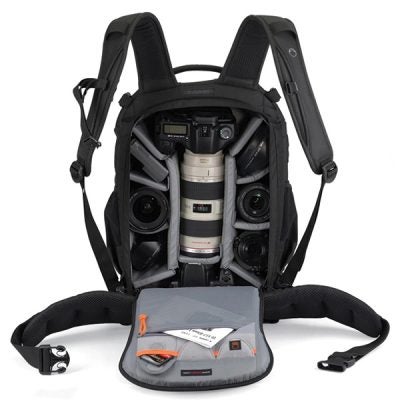We run through the key points of a camera rucksack, and round up 5 of the best on the market right now.
Camera bags come in many shapes, sizes and styles. And while shoulder bags are great for those with smaller fixed-lens cameras, they’re not all that practical for those with a DSLR or CSC plus a collection of lenses, especially if you’re going to be wearing the bag for an extended period of time.
In that case, your best bet is almost certainly a rucksack-type camera bag. As the name implies, these employ twin shoulder straps that enable you to spread the weight of your gear, making it more comfortable to carry for extended periods of time.
Not all camera rucksacks are the same though, and there are many points of differentiation between rival models. For example, some open up on the front, while others have quick-access side panels. Others are split into two sections, allowing you to store more general items in the top and your camera gear in the bottom. Some come with a waist belt, some do not.
We’ve gathered five of the best rucksacks on the market. Read on to see why we rate them and how they could benefit you.
Key points of a Camera Rucksack
Waterproof cover
Most bags are constructed from water-repellant or water-resistant material that will provide ample protection against showers. For greater protection in really wet weather, some bags also come with a protective rain cover that you can wrap around the bag to ensure everything inside stays dry.
Split compartments
Some bags divide the main internal compartment into two, allowing you to store more general items in the top and camera equipment in the bottom. This can be useful if you want to use your camera rucksack as more of a general daysack, for example when on holiday.
Shoulder straps
All camera rucksacks come with padded shoulder straps that can be adjusted to fit. The width of the straps does vary, though. As a rule wider is better, because this will ensure they don’t dig into your shoulders as much, when the bag is fully loaded.
Access points
Most bags allow you to access your camera equipment via a zipper that runs around the front of the bag, although many also offer quick-access side panels that allow you easy access without removing the bag first.
The 5 best camera rucksacks
Thule Covert DSLR Rolltop
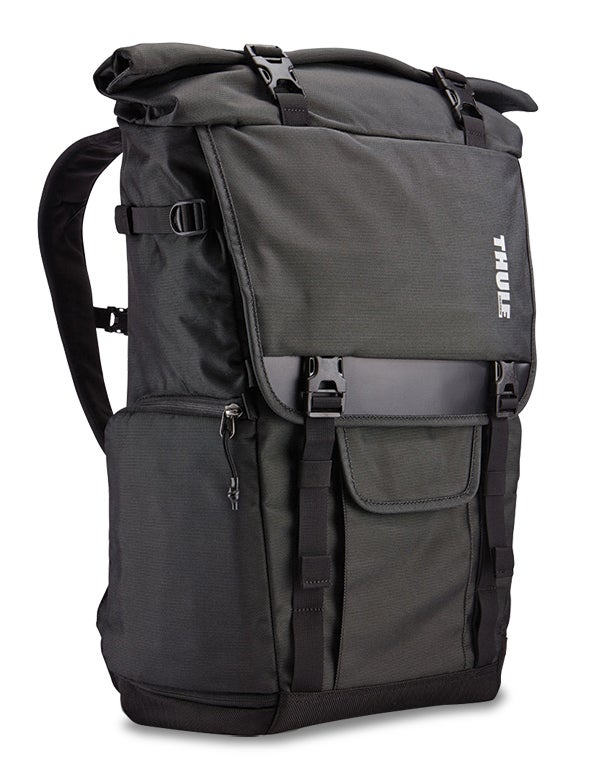
Key specs:
- Price: £100
- Laptop compartment: 15in
- External rain cover: No
- Height: 54cm
- Width: 45cm
- Depth: 20cm
- Weight: 2.26kg
The Thule Covert DSLR Rolltop is a highly flexible camera backpack that is divided into two sections:
an open, non-compartmentalised space at the top that can be used to store clothes and general items, and a padded camera section at the bottom that’s spacious enough to hold one prosumer-grade DSLR with an attached 24-105mm zoom lens, plus two spare lenses of up to 70-200mm in size (or alternatively one spare lens and a flashgun). Access to the top of the bag is via a zipped roll-top that enables you to extend the height should you need to cram a bit more in. The camera section is accessed via a zipped panel on the side of the bag, while a small tripod can be attached to the other side of the bag.
In addition, the bag sports three sleeve pockets on the front of the pack, the top two of which are protected by a flap that fastens via two buckles for added security. Rounding things off is a laptop compartment that’s positioned just behind to the wearer’s back and accessed via a zip just behind the main camera door. It’s big enough to house a 15in laptop. While there’s no built-in rain cover, the bag is constructed from water-resistant ‘Oxford’ material, while zippers are also described by Thule as being water-repellent. Both shoulder straps are padded and adjustable and complemented by a sternum strap, but there is no waist belt.
Camera equipment is stored in the bottom of the rucksack inside what Thule describes as a padded ‘SafeZone’ camera pod. This pod contains a set of dual-density padded dividers to create three individual spaces. The central space is where your DSLR sits and can be adjusted via Velcro fasteners so that your particular camera and lens combination is held more securely. The camera pod can also be wholly removed from the backpack along with the zip-out divider that divides the top section of the backpack from the bottom. This enables you to create a single large space inside should you want to use the bag as a regular daysack for non-photographic purposes.
Verdict
While the lack of a padded waist belt and the lack of an external rain cover preclude the Thule Covert DSLR Rolltop from being a suitable bag for long treks in the open countryside, it remains an excellent choice for those urban photographers looking for a flexible bag that can carry a slimmed down set of essential camera equipment alongside some more general items.
Manfrotto Professional Backpack 20
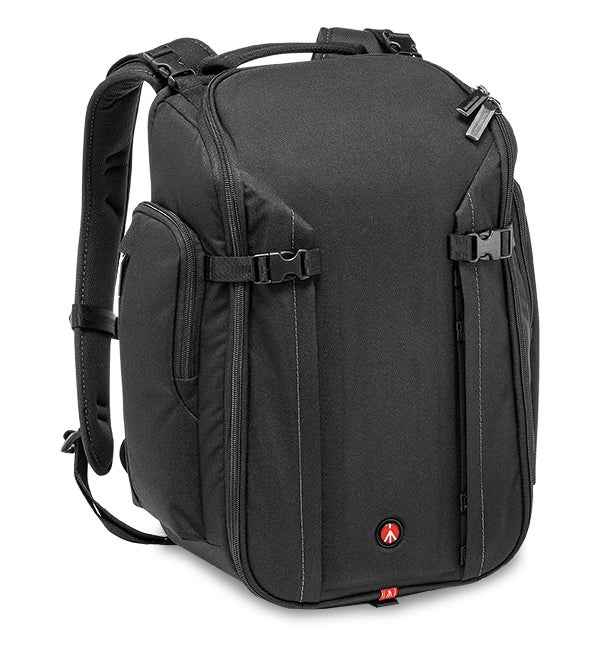
Key specs:
- Price: £110
- Laptop compartment: 13in
- External rain cover: Yes
- Height: 43.5cm
- Width: 31cm
- Depth: 20.5cm
- Weight: 1,690g
Hailing from Manfrotto’s ‘Professional’ range, the Professional Backpack 20 is designed to hold a professional-grade DSLR with attached 70-200mm f/2.8 lens, an additional camera body plus up to three extra lenses, a flashgun, a 13in tablet plus accessories. The front of the bag features straps and a tripod sock that can be used to carry a small to medium-sized tripod with.
The bag benefits from Manfrotto’s proprietary Exo-Tough Construction, which is designed to enclose your camera equipment in a soft fabric inner shell and protect it from impacts via multi-layered internal padding and a tough outer shell that provides resistance against wear and tear. In addition, the exterior of the bag has been treated with a special coating that makes it water repellent. This is to ensure that small to moderate amounts of water just run straight off the bag, although the rucksack also features a built-in rain cover that can be pulled out and extended over the entirety of the bag for increased protection in heavier rain or more prolonged downpours.
The main compartment is accessed from the front of the bag, via a zip that runs around the outside. Once inside, you are free to re-arrange the internal compartments as you like to fit your own equipment. The laptop pouch is accessed from a separate zip between the main compartment and the shoulder straps, making it impossible for anyone to access while you are wearing the bag. In addition to the main compartment and laptop pouch, the Professional Backpack 20 also features two side pockets that can be used to store everyday items such as maps, keys or mobile phones.
The backpack is held in place via two padded shoulder straps that are also fully adjustable. The shoulder straps can be pulled together for better weight distribution via a sternum strap. There is also a waist strap – however, it is not padded.
Verdict
The Manfrotto Professional Backpack 20 is an extremely well-made and durable rucksack that is able to carry a decent amount of equipment, and still have a bit of room left over for other small non-photographic accessories. While a padded waist belt would undoubtedly make it more comfortable to wear for extended periods of time, it nonetheless remains an excellent rucksack for shorter treks.
Tamrac Corona 14
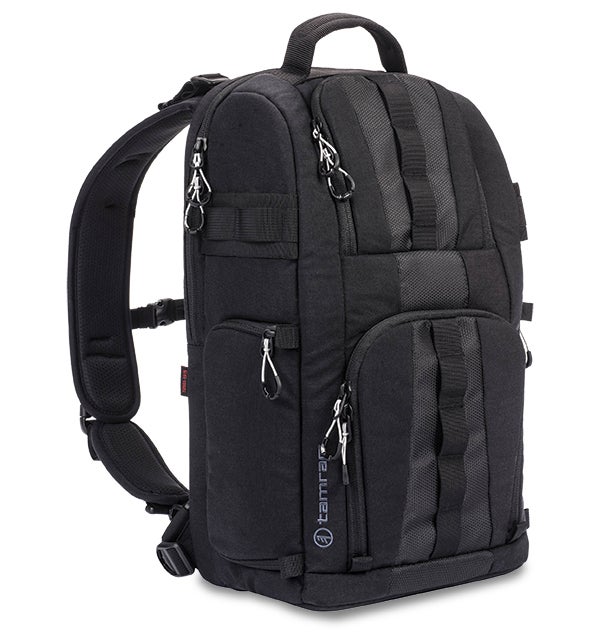
Key specs:
- Price: £130
- Laptop compartment 13in
- External rain cover Yes
- Height 44cm
- Width 27cm
- Depth 21cm
- Weight 1,200g
Designed for street and action sports photographers Tamrac’s Corona range is available in three sizes – 14, 20 and 24. The Corona 14 is the smallest of the three and provides enough internal space to house a DSLR with attached 24-70mm f/2.8 lens, plus up to four additional lenses – three if you’d prefer to use one of the padded compartments for a flashgun instead. The Corona 14’s detachable shoulder straps enables it to be worn in one of two ways: as a traditional double shoulder-strap rucksack, or as a sling-style bag.
To make the transformation from rucksack to sling bag, you simply remove one of the straps and fasten the other to the opposite corner.
A removable central divider splits the bag into two main sections: an open space at the top that’s accessed via a zipper on the front and which can be used to store everyday items and clothes; and a compartmentalised camera storage area at the bottom. Increasing the bag’s flexibility for both right and left-handed users, there are side access zippers on both sides. These come with small see-through pockets for memory cards and the like. Another zipper is on the front of the bag, which gains you access to the whole bottom compartment including your lenses. While there are no side pockets, the bag does have a sleeve compartment that’s big enough to house a 13in laptop. Tripods can be securely attached to the front of the bag.
Both the shoulder straps are wide and well padded, and come with a sternum strap to help weight distribution. The back of the bag is anatomically padded in all the right places and features an airflow system to reduce perspiration. While the bag is not supplied with a waistbelt, it is possible to add a removable Tamrac ARC belt (£43) to help distribute heavier loads over longer periods of time. You can also hang other ARC pockets and sleeves on it. The exterior of the bag is constructed from water-resistant material, and a protective rain cover is also supplied.
Verdict
The Tamrac Corona 14 is a stylish and flexible rucksack that provides plenty of space along with the flexibility to get directly to your camera from both sides of the bag. The open top section also increases the bag’s usefulness as a general daysack, allowing you to store essential everyday items as well as your camera equipment.
Vanguard UP-Rise II 48
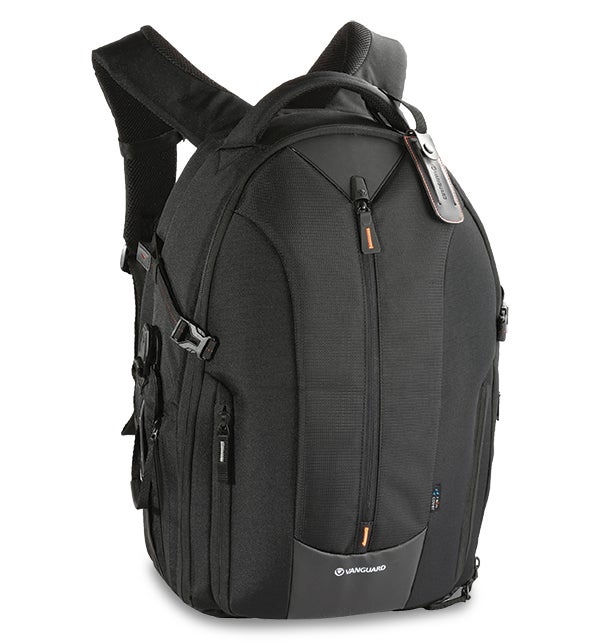
Key specs:
- Price: £110
- Laptop compartment: 15in
- External rain cover: Yes
- Height: 52cm
- Width: 34cm
- Depth: 27cm
- Weight: 2kg
This large and tough backpack features an innovative expansion system that allows you to extend its storage capabilities with a single zipper motion. The bag is designed to hold up to two professional grade DSLRs, plus up to five lenses and a flashgun in the main compartment, with a separate sleeve that can accommodate a 15in laptop.
Opening the bag reveals a large main internal compartment that in addition to being spacious is generously served by padded dividers. These dividers can be rearranged to suit the needs of your equipment. In order to fully open the bag, however, you’ll need to undo two quick-release buckles on the side of the bag. If you keep these buckles in place then the zipper is prevented from going more than halfway, effectively dividing the bag into two sections. Depending on how you organise the inside, this could allow you to have an open top section for general items and a compartmentalised bottom section for your camera. The front of the bag features a zipper that opens to reveal additional storage space for thin items such as books or maps.
For those looking to get to their camera quickly, the UP-Rise II 48 features a quick-access panel on the side that allows you to swivel the bag on one shoulder and quickly get to your camera. On the other side, the bag features a concealed tripod sock plus retaining straps that allows you to easily attach a tripod with. Alternatively, the side pocket can also be used to store a water bottle or similar.
The bag is constructed from water-resistant material and is also supplied with an external rain cover for added protection.
Despite the lack of a waist belt, the shoulder straps are well padded and fully adjustable, rounded off by a sternum strap to help distribute weight more evenly. The back of the bag is anatomically padded with what Vanguard describes as ‘3D mesh’ and is channeled to let more air circulate between the bag and the wearer’s back with the aim of reducing perspiration.
Verdict
While the Vanguard UP-Rise II 48 is light on quick-access external pockets, it remains a spacious and flexible bag that can be easily tailored to suit your equipment. The use of water-resistant material and plenty of padding also ensures that your equipment is kept secure and safe. Overall, it’s a great bag for those photographers with lots of equipment to carry.
LowePro Flipside 400 AW
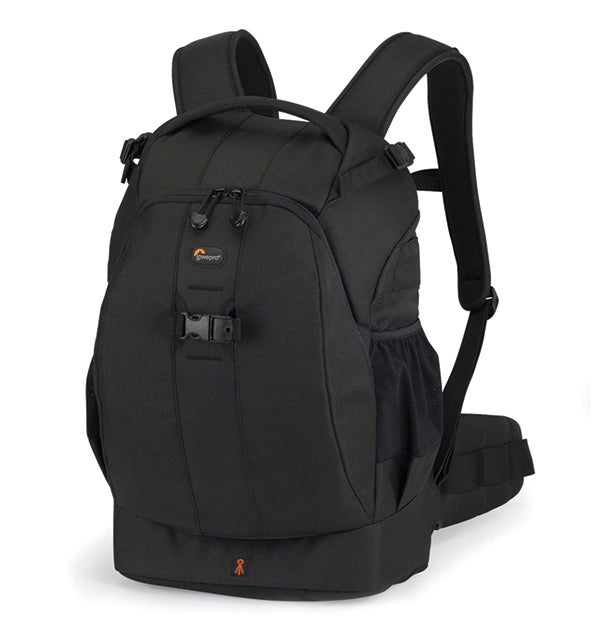
Key specs:
- Price: £80
- Laptop compartment: No
- External rain cover: Yes
- Height: 46cm
- Width: 30cm
- Depth: 25.3cm
- Weight: 1.6kg
Lowepro’s popular Flipside range currently consists of four models – the 200, 300, 400 AW and 500 AW – that gradually increase in size and overall capacity. The 400 AW is a large-capacity bag that’s available in either black or pine green and is designed to hold a professional-grade DSLR with a large telephoto lens (up to 300mm) attached, along with an additional camera body, between four and six lenses, a flashgun and other smaller accessories such as memory cards, spare batteries and filters.
Unlike many other rucksack-style camera bags the main compartment is not split into two. Instead, the spacious main compartment employs a series of padded dividers that you can arrange as you want, providing plenty of flexibility to arrange them around your own camera equipment so it’s all held firmly and securely in place. While the Flipside 400 AW does offer a front pocket for storing small personal items, and two small mesh side pockets, there is no dedicated space to store a laptop inside. The front of the bag is fitted with what Lowepro describes as a Hideaway Tripod Mount, that allows you to secure a tripod. In addition, the bag is supplied with a number of SlipLock attachment loops that enable you to add further storage pouches and accessories.
One of the main differentiating factors about the Flipside 400AW is that access to the bag is gained from a zipper on the back, rather than the front. Unlike many other camera rucksacks, the 400 AW doesn’t provide side-access panels either. This approach means that would-be thieves will find it all but impossible to unzip your bag while you’re wearing it. In combination with the padded waist strap, this is also how the bag gets its name. The basic idea is with the waist strap secured you can remove the shoulder straps, ‘flip’ (or swivel) the bag around so that it is in front of you and access the main camera compartment directly. Because the padded waist belt is firmly secured by a chunky clip-in buckle you can essentially use the bag as a sort of table. You can even use it to change lenses on the go without having to remove the bag.
The shoulder straps are well padded, fully adjustable and quite wide, which helps to ensure that the bag doesn’t dig into your shoulders under heavy load. A sternum strap is also supplied which helps to distribute weight more evenly. The Lowepro 400 AW is also the only bag in this month’s Top Five to come with a built-in waist belt. If you’re carrying a lot of heavy equipment then a waist belt is definitely a good idea, as it will spread the weight between your waist and your shoulders, making the bag more comfortable to wear over longer periods. The 400 AW is constructed from water-resistant fabric, and also contains a built-in All Weather AW cover for use in more inclement conditions.
Verdict
The Lowepro Flipside 400 AW is an extremely spacious rucksack that will doubtless appeal to those photographers with a lot of equipment to carry around. The rear-access design makes it a practical bag for those looking to maximise the security of their equipment, while the inclusion of a padded waist belt also makes it especially well suited to landscape photographers looking to get out into the hills with a tonne of gear.





